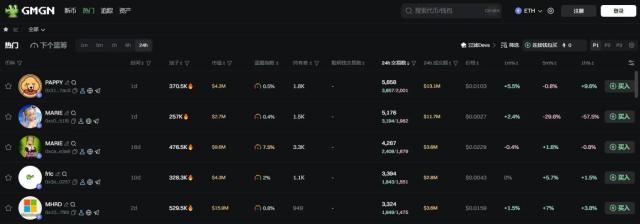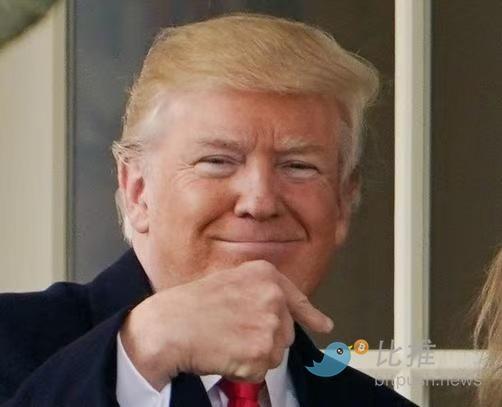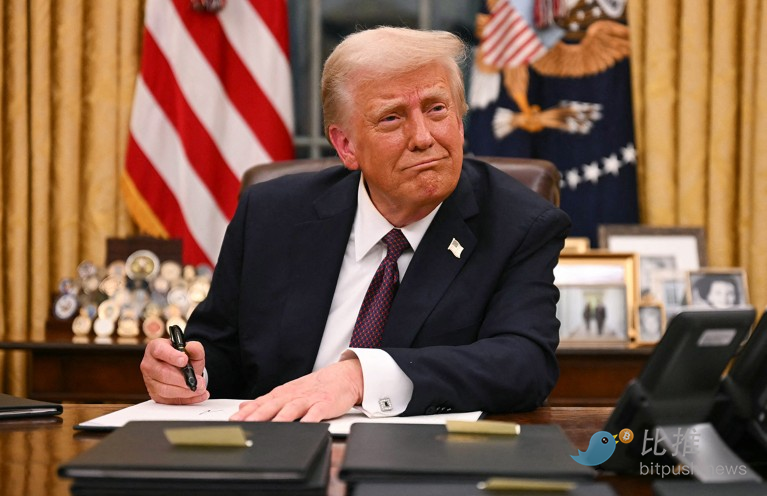
On August 7, 2025, a stroke that would leave a significant mark on the history of American finance quietly fell into place.
Trump signed an executive order allowing U.S. retirement savings accounts 401(k) to officially invest in "alternative assets" including cryptocurrencies, private equity, and real estate. From now on, an asset class once rejected by the mainstream financial system has been officially written into the U.S. retirement plan worth nearly $9 trillion.
This is not only a key turning point in regulatory attitude but also potentially the critical point for digital assets to truly become mainstream.
From Marginal Asset to Mainstream Channel: The Leverage Effect of an Executive Order
For a long time, the U.S. 401(k) plan - a retirement savings tool serving 90 million workers - primarily invested in traditional assets: stocks, bonds, and index funds like the S&P500 ETF. Alternative assets, such as cryptocurrencies, although increasingly active in the market, were long excluded from the retirement system, with regulatory agencies maintaining a cautious or even hostile attitude.
But in 2025, everything began to change. Washington released unprecedented goodwill towards digital assets, with the Trump administration actively pushing a "deregulation" wave, and crypto assets becoming one of the most favored roles in this wave.
Trump's new executive order requires the Department of Labor to re-evaluate the relevant provisions in the Employee Retirement Income Security Act (ERISA), "providing a path" for 401(k) plans to include digital assets and private investments, and reserving space for regulators to "adjust the rules".
According to the Financial Times, Trump's deep connection with the crypto industry played a role: "If only private equity were involved, the order would likely not have moved forward; it was cryptocurrency that ultimately made Trump sign off."
How Much Allocation? How Much Funding?
According to the latest data, the scale of the U.S. 401(k) plan is extremely large. As of the end of the first quarter of 2025, the total assets of employer-provided 401(k) plans were approximately $8.7 trillion. The total assets of the entire U.S. retirement market (including 401(k), IRA, etc.) are as high as $43.4 trillion.
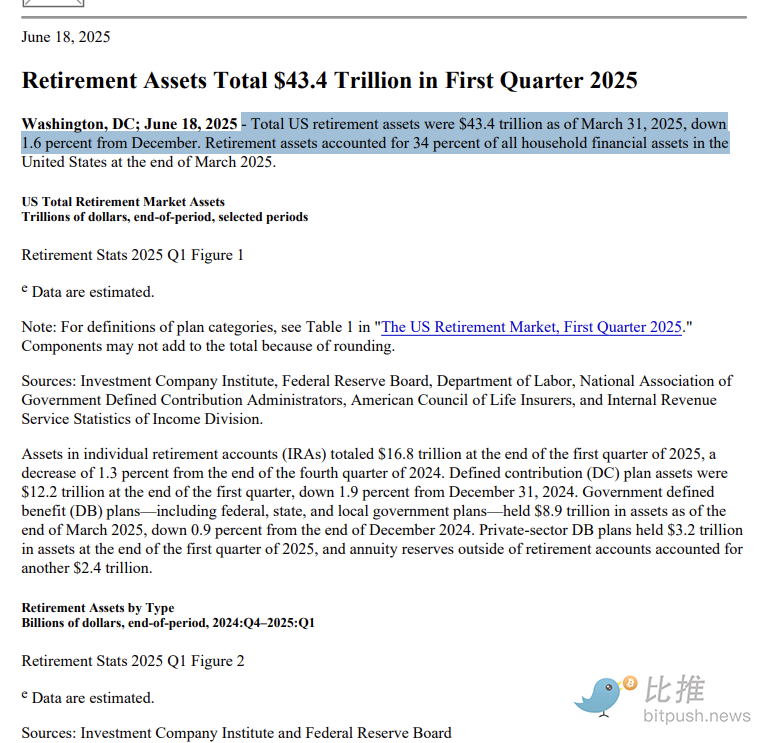
So, how much funding could be allocated to cryptocurrencies? Currently, there is no exact figure.
Tom Dunleavy, Managing Director of Varys Capital, offered a hypothesis:
"If each American's 401(k) account allocates 1% of existing assets to cryptocurrencies, $12 billion will flow into the crypto market. If it's 3%, that's $36 billion; at 5%, it reaches $60 billion."
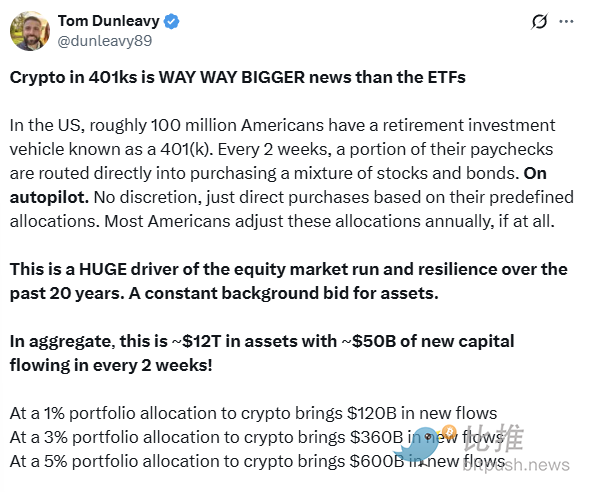
This is a long-term and stable capital inflow path: Most Americans automatically transfer a portion of their wages to 401(k) every two weeks, and once digital assets are included in the asset pool, it means continuous passive buying behavior.
For a market still characterized by volatility, this is not just funding, but also an emotional bottom. "This will provide a more stable price support range for Bitcoin and Ethereum," Dunleavy stated.
Ryan Rasmussen, Research Director at Bitwise, added:
"In the short term, this executive order signals to the market that crypto assets have moved from the margins to institutional recognition."
ETF: The Best Bridging Method
In addition to direct inclusion in the 401(k) asset pool, crypto ETFs are seen as the most promising channel.
By mid-2025, Bitcoin and Ethereum-related ETFs had attracted over $13 billion in net inflows. BlackRock's iShares Bitcoin Trust (IBIT) and VanEck's Ethereum ETF (ETHV) achieved 20% and 11% year-to-date returns, respectively.
The benefits of ETFs are obvious:
No need to open a crypto wallet;
No need to operate decentralized exchanges;
Issued by regulated fund companies;
Can be included in investment portfolios alongside traditional assets.
Just like buying a GLD gold ETF is far more convenient than purchasing physical gold bars, ETFs have become the preferred tool for retirement investors to enter the crypto market.
How Far from Real Execution?
Trump's executive order can release directional signals, but between "written on paper" and "appearing in accounts" lie multiple practical obstacles. This reform of crypto assets entering 401(k) is currently in the gap between "policy intent" and "execution reality".
We can analyze the complexity of this implementation path from three dimensions:
Regulatory Barriers Not Yet Completely Removed
Although the president signed the executive order, the order itself does not immediately have the power to change regulations. Its role is to instruct agencies like the Department of Labor (DoL) and Securities and Exchange Commission (SEC) to "re-evaluate and modify" current regulatory rules.
According to CNBC, current 401(k) plans are governed by the Employee Retirement Income Security Act (ERISA), which explicitly requires trustees to follow the "prudent man rule" to maximize participant benefits. However, the high volatility, poor liquidity, and non-transparent valuation characteristics of crypto assets make it difficult to pass the prudence test. In 2022, Fidelity proposed a Bitcoin allocation option for 401(k), which was immediately questioned by the Department of Labor and faced review pressure. Although the policy direction changed in 2025, with details yet to be published, fund providers acting rashly still face potential compliance litigation risks.
Plan Providers' Practical Concerns: Not Wanting to Be Scapegoats
401(k) plans are mostly operated by employers in collaboration with third-party service providers, involving large platforms like Vanguard, Fidelity, and Empower. However, as of now, many platforms generally maintain a cautious wait-and-see attitude towards crypto options.
The main reasons include:
High legal liability: If investors suffer losses, fund managers and employers may be sued for "failure to fulfill fiduciary responsibilities";
Lack of investor education: Most 401(k) users lack understanding of crypto assets and are prone to misjudging risks;
High technical integration costs: Introducing new asset classes requires re-interfacing risk control systems, reporting logic, and KYC processes, which is no small project.
Therefore, in the short term, even if policy allows, most crypto investments will still need to be conducted through the "Self-Directed Brokerage Window" channel, which currently mainly exists in some large companies' 401(k) plans. This method is usually only used by a few employees with in-depth investment knowledge. As a core investment option, spot Bitcoin and Ethereum ETFs are most likely to be the carrier, as these products are relatively mature and more highly regulated.
The Uncertainty of the Crypto Market Itself Remains the Biggest Variable
Even with regulatory relaxation and execution willingness, whether the crypto market is truly ready to accept long-term capital remains unknown.
Bitcoin and Ethereum have rebounded significantly this year but still accompany over 30% daily volatility;
Leveraged ETFs and on-chain contract products are emerging, further amplifying retail investor risks;
The shadow of platform collapses like FTX has not completely dissipated, and investor trust is still being rebuilt;
For many regulators, crypto assets still lack predictability and stable return logic.
On CNBC's "ETF Edge" program, Sal Gilbertie, president of Teucrium Trading, pointed out: "Leveraged crypto ETFs are aggressive products not suitable for retirement portfolios—they are designed for day trading".
From "Margin to Core", Sixteen Years Passed
From Satoshi Nakamoto mining the first Bit in 2009 to its inclusion in the US retirement system in 2025, it took 16 years.
This transformation from "margin to core" is not accidental, but the result of multiple forces—political motivations, investment consensus, market logic, and technological progress—intertwining.
One fact that must be acknowledged is that the Trump family and their core circle have close business ties with the cryptocurrency industry. Public data shows that their family assets have already invested billions of dollars in cryptocurrencies and related enterprises. The process of cryptocurrencies moving from the margin to the mainstream reflects changes in regulatory attitudes and has sparked discussions about the relationship between power and capital.
Today, with cryptocurrencies being incorporated into 401(k) retirement plans, their role has fundamentally changed—no longer just a speculative asset, but gradually becoming a component of the national financial system. However, this transformation has just begun. Whether cryptocurrencies can truly become a reliable retirement investment option remains to be seen. Currently, it still faces multiple challenges such as market volatility, regulatory frameworks, and long-term value. Ultimately, this experiment is not just about investment returns, but may potentially reshape the future financial system's landscape.
Twitter: https://twitter.com/BitpushNewsCN
BitPush TG Community: https://t.me/BitPushCommunity
BitPush TG Subscription: https://t.me/bitpush




